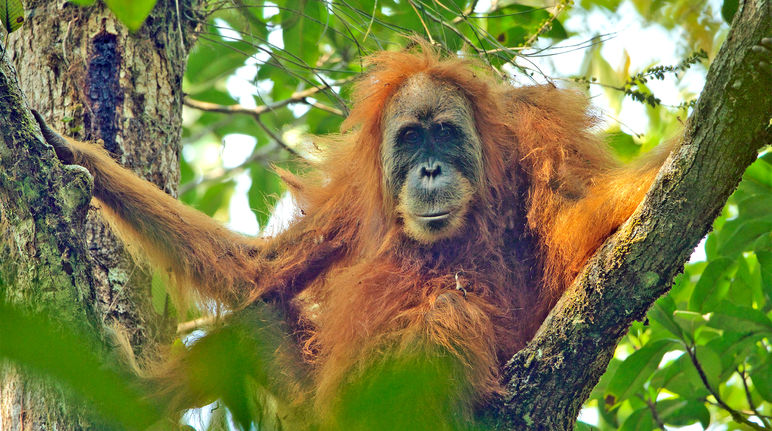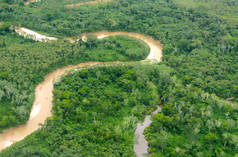Stop bulldozing the Tapanuli orangutan!
 The Tapanuli orangutan: newly discovered and soon to be extinct (© Tim Laman/CC BY 4.0)
The Tapanuli orangutan: newly discovered and soon to be extinct (© Tim Laman/CC BY 4.0)
The Tapanuli orangutan is a sensational discovery – it was only recognized as a distinct species in 2017 and it is already facing extinction. Only 800 individuals remain, hidden in a small patch of forest in northern Sumatra. A Chinese hydropower project may soon destroy their habitat.
News and updates Call to actionTo: President of China Xi Jinping, President of Indonesia Joko Widodo, CEO of Sinohydro, CEOs of the state-owned utility PLN
“The welfare of the Tapanuli orangutan is more important than generating electricity – scrap the plans for Batang Toru dam!”
With their long, wavy hair, the orangutans in the forests of Tapanuli in North Sumatra, Indonesia, are strikingly different than their relatives elsewhere on Sumatra and on Borneo. The calls of the males could be mistaken for a human language.
It was only in November 2017 that scientists found that the orangutans in Tapanuli are a distinct species and not a subspecies of the Sumatran orangutan. They gave them the name Pongo tapanuliensis. Genome analyses have shown that the Tapanuli orangutan split from the Borneo orangutan line 670,000 years ago. Pongo tapanuliensis is thus the rarest and most critically endangered orangutan species.
This discovery shows us just how little we know about our closest relatives and how incomplete our understanding of biodiversity remains. Humans are driving other species to extinction faster than we can discover and document them. The Tapanuli orangutans will also face that fate if a massive hydropower project is realized in their habitat.
800 individuals – the last of their kind – cling to survival in a forest south of Lake Toba. In Batang Toru Forest, the state-owned Chinese hydropower company Sinohydro wants to build a dam for a 510 MW power plant as part of China's Belt & Road mega-infrastructure initiative.
Wildlife experts are horrified: The dam would destroy the only habitat of the Tapanuli orangutan, marking the beginning of the end of the world’s rarest primate.
Do we really want to sentence our closest relatives to death for a couple hundred megawatts of electricity? Tell the Indonesian and Chinese governments to cancel their plans NOW!
BackgroundThe Tapanuli orangutan
“There is a third species of orangutan and somehow nobody noticed”, wrote New Scientist in November 2017.
It has long been known that orangutans live in the forests southwest of Lake Toba. Until recently, they had been considered a subspecies of the Sumatran orangutan. But studies of their genome, morphology and behavior have shown that this orangutan is a distinct species.
In the journal Current Biology, researchers conclude from their analyses that Tapanuli orangutans are much more closely related to Borneo orangutans (Pongo pygmeus) than to Sumatran orangutans (Pongo abelii), which live only a few hundred kilometers away. The Borneo and Sumatran orangutan lines separated 3.4 million years ago, whereas the Tapanuli orangutan split off the Borneo line a mere 670,000 years ago. Sumatra and Borneo were interconnected at the time because of the low sea level.
The Batang Toru forest
The Batang Toru Ecosystem, a major water catchment area with rugged terrain, diverse rainforest types and high biodiversity, lies southwest of Lake Toba in North Sumatra. The surrounding villages and fields, as well as areas further afield, depend on the water of the ecosystem. The forests also provide protection against erosion and flooding. Last but not least, they serve as a carbon sink and are therefore of great importance for the global and local climate in otherwise largely deforested Sumatra.
While parts of the forests are protected, the most ecologically valuable areas are not. A gold mine in the south – which has leveled an entire mountain – as well as poaching and illegal logging are serious threats to the area’s biodiversity. In the years from 2001 to 2010 alone, 35 square kilometers of – mostly protected – forest were destroyed. Roads cut through ecologically fragile areas, and oil palm and rubber plantations extend into the peripheral areas.
In addition to orangutans, other endangered species such as the Sumatra tiger and the pangolin live at higher elevations in the region. According to wildlife studies in recent years, the Batang Toru Ecosystem is home to nearly 100 mammal species, 18 of which are on the IUCN Red List of endangered species.
The Batang Toru dam
The Batang Toru dam is part of a 510MW power plant project by PT North Sumatra Hydro Energy (PNSHE), Beijing Engineering Corporation and Sinohydro Bureau 10 Co Ltd. and financed by Goldman Sachs. PNSHE has already acquired 559 hectares of the planned 645 hectares.
The dam is planned in the area that has the highest orangutan density. The access roads and overhead line routes will further fragment the entire region and isolate the orangutan populations from each other. The construction of the Batang Toru hydropower project could lead to the extinction of the recently discovered Tapanuli orangutan.
The project is part of China’s “New Silk Road”.
The New Silk Road
With its ambitious New Silk Road (Belt and Road Initiative, BRI, or One Belt One Road, OBOR) project, China wants to expand its economic relations with emerging countries and link Asia more closely to Africa and Europe by land and sea. This includes the expansion of transport routes, numerous infrastructure projects and the development of markets in Central and Southeast Asia, Africa and Europe. At present, the New Silk Road is still more of a patchwork of large-scale projects than an obviously coherent plan. The Asian Infrastructure Investment Bank (AIIB) and the Silk Road Fund serve as financing instruments. The Asian Development Bank has expressed its interest, as have Deutsche Bank and other international banks.
The New Silk Road will change the economic fabric of the world. At the same time, it will put enormous pressure on the climate and the environment. The relationship of China and its neighbors in Asia will be crucial for the conservation or loss of biodiversity, for the global climate and for the future of indigenous people and subsistence farmers.
The Batang Toru dam is just a glimpse of how profound the impact of the New Silk Road could become.
There is also the danger that the partner countries could unwittingly become dependent on China, as Sri Lanka has done after being unable to service Chinese loans related to a BRI infrastructure project. Indonesia’s economic sovereignty could also suffer from the Batang Toru Dam.
To: President of China Xi Jinping, President of Indonesia Joko Widodo, CEO of Sinohydro, CEOs of the state-owned utility PLN
Dear President Xi Jinping, dear President Joko Widodo, Ladies and Gentlemen,
The rare Tapanuli orangutan, identified as a distinct species only in 2017, lives in the forests of Batang Toru. The scientific analyses of their genome, morphology and behavior proved sensational: Indonesia is thus home to three distinct orangutan species. All three are highly vulnerable, but the newly discovered species is in particularly grave danger of extinction. Mining, logging, poaching and plantations are already decimating the biologically rich and diverse forests of Batang Toru. Scientists urge us to protect the habitat of the Tapanuli orangutans immediately and with great vigor.
It is precisely in this ecologically crucial area that Sinohydro is planning a dam for a 510MW power plant. The dam would cut through the habitat of the Tapanuli orangutans, isolate the individual populations and partially flood the area.
We call on you to do everything in your power to protect the Tapanuli orangutan. Do not allow yourself to become guilty of the extinction of some of our closest relatives. Do not sacrifice the foundations of life for short-term economic interests!
The planning of such major projects as the Batang Toru dam must take ecological and social criteria fully and unconditionally into account.
Do not build a dam in the habitat of the Tapanuli orangutan.
Yours faithfully,
Chinese hydropower: extinction for the Tapanuli orangutan?

Indonesia’s Tapanuli orangutan, which was only identified as a distinct species two years ago, is now on the list of the 25 most endangered primates: a Chinese hydroelectric dam project on Sumatra could destroy the tiny habitat of the remaining 800 apes.
Sierra Leone rejects Chinese-funded “One Belt, One Road” airport
Great news for nature in Sierra Leone: by nixing the construction of a new Chinese-funded international airport, the tiny West African country is resisting China's “One Belt, One Road” infrastructure initiative – a project that has been described as the most environmentally risky venture of the century.
China's “Belt & Road Initiative” – and what it means for the planet
Orangutans or hydropower? China's mega-initiative and its impact on the last pockets of wilderness in Southeast Asia and elsewhere, explained.
ALERT urges Indonesian president: save the world's rarest ape
In a letter hand-delivered on Monday, July 9th, 25 world-leading scientists from ALERT urged Indonesian President Joko Widodo to halt a hydropower project in northern Sumatra that would imperil the rarest great ape in the world.
This petition is also available in the following languages:
Help us reach 400,000:










